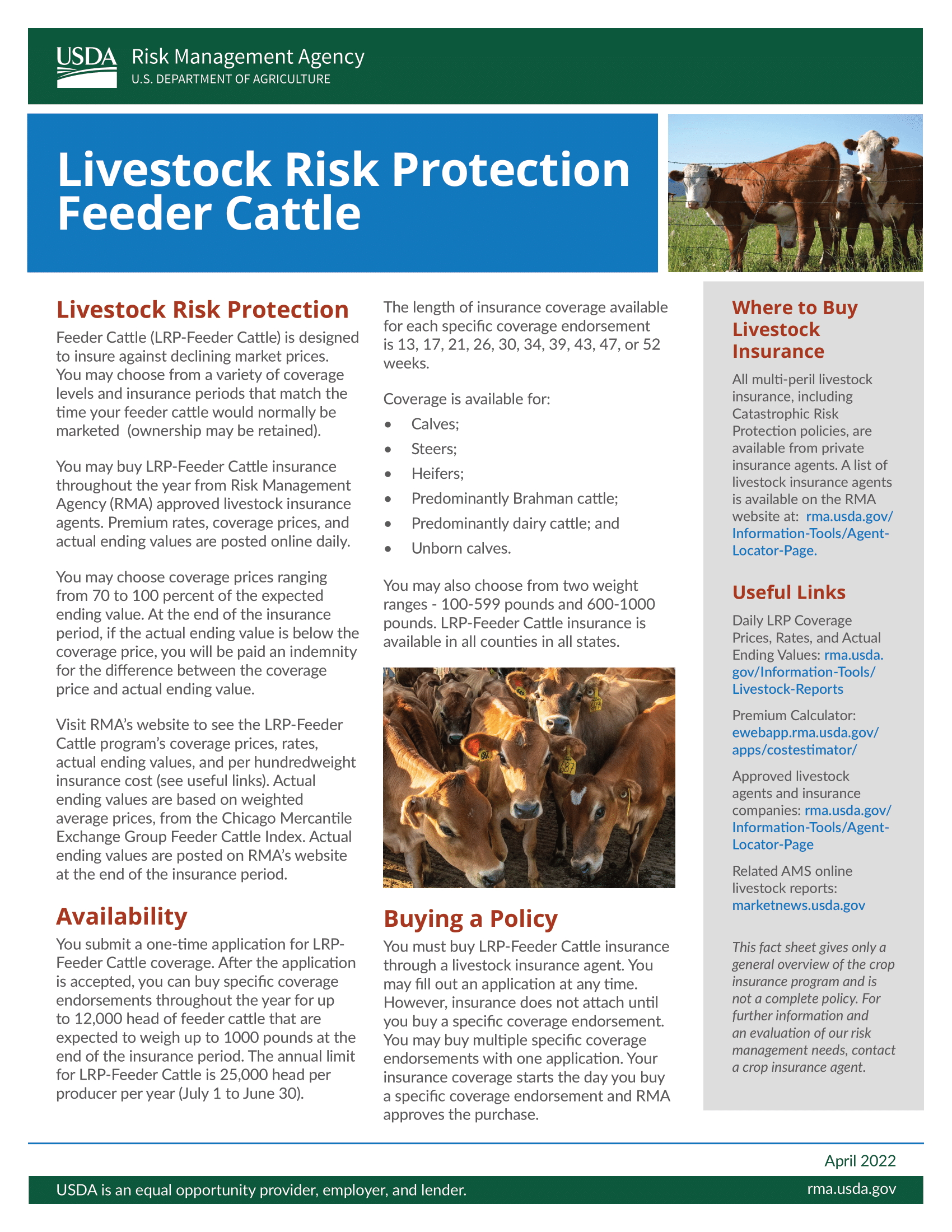Encourage Your Service: Bagley Risk Management Insights
Wiki Article
Trick Factors to Consider When Deciding On Livestock Risk Protection (LRP) Insurance
When assessing options for Animals Threat Security (LRP) insurance policy, a number of vital aspects require mindful consideration to guarantee efficient risk administration in the agricultural sector. Choosing the right coverage choices customized to your particular animals operation is critical, as is recognizing how premium prices associate with the degree of defense supplied.Coverage Options
When thinking about Animals Threat Defense (LRP) insurance coverage, it is important to recognize the various insurance coverage options available to mitigate risks in the farming industry. Animals Risk Security (LRP) insurance coverage uses different coverage choices tailored to meet the varied requirements of animals manufacturers. Bagley Risk Management. Among the main coverage options is rate protection, which shields against a decline in market prices. Producers can pick the insurance coverage degree that aligns with their price danger monitoring objectives, enabling them to secure their procedures versus prospective economic losses.One more essential insurance coverage alternative is the endorsement duration, which identifies the length of time the protection holds. Producers can pick the endorsement duration that finest matches their production cycle and market problems. Furthermore, coverage degrees and prices differ based on the kind of livestock being guaranteed, giving manufacturers the adaptability to tailor their insurance plans according to their details needs.
Understanding the different coverage choices available under Animals Risk Protection (LRP) insurance is essential for manufacturers to make educated decisions that properly shield their livestock procedures from market uncertainties.
Costs Costs

Animals Danger Protection (LRP) insurance gives essential coverage choices customized to mitigate risks in the agricultural sector, with a substantial facet to consider being the calculation and structure of premium expenses. These include the type and number of livestock being insured, the coverage level selected, the current market costs, historical cost data, and the size of the coverage period.
Insurance companies assess historic information on animals prices and manufacturing expenses to figure out a suitable costs that reflects the level of danger involved. It is crucial for animals producers to very carefully examine premium prices and protection alternatives to guarantee they are effectively safeguarded against prospective monetary losses due to damaging market conditions or unanticipated occasions.
Eligible Livestock
The determination of eligible animals for Animals Danger Defense (LRP) insurance policy coverage entails mindful factor to consider of details standards and features. Livestock types that are generally qualified for LRP insurance coverage include feeder livestock, fed lambs, cattle, and swine.Feeder livestock, for instance, are frequently eligible for LRP insurance coverage if they drop within specified weight arrays. Fed cattle might additionally be qualified, yet they must fulfill specific weight and high quality grade demands. Swine eligible for protection typically include market weight pets intended for slaughter. Lambs are another category of livestock that can be thought about for LRP insurance, with elements such as weight and age playing a crucial role in you can check here identifying their eligibility.
Before selecting LRP insurance coverage for animals, manufacturers need to thoroughly review the eligibility standards outlined by the insurance find more info coverage carrier to guarantee their pets fulfill the essential needs for coverage.
Policy Flexibility
Plan versatility in Livestock Danger Protection (LRP) insurance coverage allows producers to customize protection to match their particular demands and risk administration approaches. This adaptability encourages animals manufacturers to tailor their insurance policy plans based on elements such as the type of livestock they have, market conditions, and specific danger tolerance degrees. By using personalized options, LRP insurance coverage enables manufacturers to effectively manage their risk exposure while protecting their livestock procedures versus unanticipated market volatility.Claims Process
Upon experiencing a loss or damages, manufacturers can start the claims procedure for their Animals Risk Defense (LRP) insurance policy by immediately contacting their insurance provider. It is critical for producers to report the loss as soon as possible to accelerate the claims process. When connecting to the insurance provider, manufacturers will certainly need to offer detailed information about the incident, including the date, nature of the loss, and any kind of relevant documents such as vet records or market prices.
After the evaluation is total, the insurance coverage company will make a decision relating to the claim and connect the end result to the producer. The producer will certainly receive settlement according to the terms of their Livestock Threat Defense (LRP) insurance browse around this web-site coverage policy if the insurance claim is authorized. It is vital for manufacturers to be familiar with the cases process to make certain a smooth experience in the occasion of a loss

Conclusion
Finally, when selecting Animals Danger Security (LRP) insurance coverage, it is necessary to take into consideration coverage choices, premium prices, eligible livestock, policy versatility, and the insurance claims procedure. These crucial factors will certainly help ensure that ranchers and farmers are adequately safeguarded against prospective risks and losses associated with their animals procedures. Making a notified decision based on these factors to consider can eventually lead to much better economic safety and satisfaction for animals manufacturers.Animals Threat Defense (LRP) insurance uses various coverage alternatives tailored to meet the diverse requirements of livestock manufacturers.The decision of eligible animals for Animals Threat Security (LRP) insurance policy protection entails mindful consideration of details requirements and qualities.Plan flexibility in Animals Risk Defense (LRP) insurance allows producers to tailor coverage to suit their certain needs and run the risk of administration methods.Upon experiencing a loss or damages, producers can start the insurance claims procedure for their Animals Danger Defense (LRP) insurance by immediately contacting their insurance policy carrier.In verdict, when choosing Livestock Danger Security (LRP) insurance policy, it is essential to consider coverage alternatives, premium expenses, eligible livestock, plan versatility, and the cases process.
Report this wiki page